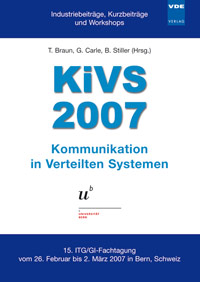A Graph-based Simple Mobility Model
Konferenz: KiVS 2007 - Kommunikation in Verteilten Systemen - 15. ITG/GI-Fachtagung
26.02.2007 - 02.03.2007 in Bern, Schweiz
Tagungsband: KiVS 2007
Seiten: 12Sprache: EnglischTyp: PDF
Persönliche VDE-Mitglieder erhalten auf diesen Artikel 10% Rabatt
Autoren:
Mogre, Parag S.; Hollick, Matthias; Heureuse, Nico d'; Heckel, Hans Werner; Krop, Tronje; Steinmetz, Ralf (Multimedia Communications Lab (KOM), Technische Universität Darmstadt, Merckstr. 25, 64283 Darmstadt, Germany)
Inhalt:
Simulation of mobile ad hoc networks requires mobility models to calculate the movement of the mobile nodes being simulated. Due to their simplicity and ease of instantiation, random mobility models are very popular in the research community. However, these models cannot easily be used to realistically model the movement of nodes in an urban scenario (i.e., terminals carried by pedestrians or in cars). Many of the existing mobility models for urban environments are based on extensive empirical data collection and, hence, are quite complex and inflexible.We adapted existing random mobility models to model movement within a city more realistically, while keeping the virtue and simplicity of random models. Our new models are graph-based, where the graph represents the streets of a city. Realistic speeds are assigned to the nodes, and, as in real life, nodes can travel together in a group. Thus, the work presented in this paper enables the use of simple and realistic random mobility models in a city scenario. Additionally, our models are designed to avoid the common pitfalls of existing random mobility models.


